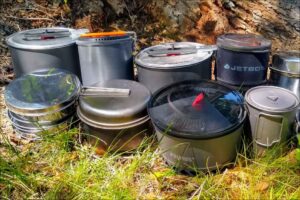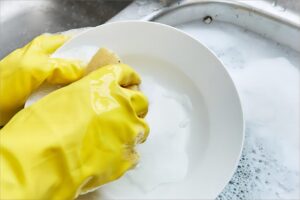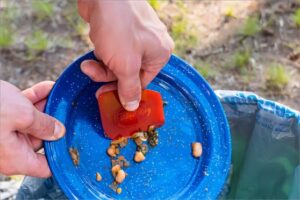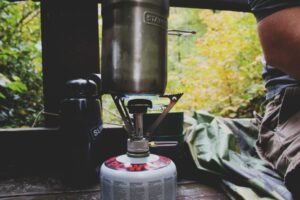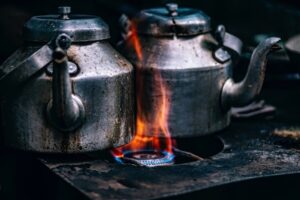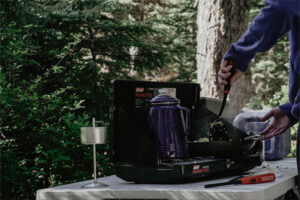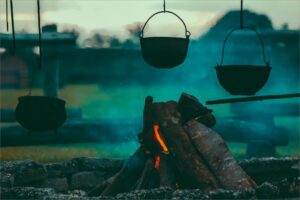
We recommend that travellers use cooking equipment to hydrate food rather than stand-up plastic pouches. This collection of recommendations should assist you with the task of cleaning up when hiking.
Below are three popular methods used to clean dishes while on the trail:
The “Express Quick Clean”
Remove Large Excess Food – Add any uneaten food in a Ziplock bag or similar container that you bring with your food.
Add Clean Water – Add a small amount of filtered water to the pot.
Perform a Finger Scrub – Using your index or similar finger, wipe clean all areas that have come into touch with food, usually the whole inside and lip.
Clean Rinse – Using clean water, add enough to rinse the dirt around and discard.
Dispose of Dirty Water – Dig a hole comparable to a cat hole 200’ from camp and water, then pour dirty wash water into it and cover it as usual.
Dry – This should be easy with any tiny camp towel you have or one of those small compressed towels.
Washing Dishes with Soap
The normal and more traditional method of cleaning is with soap and water. Soap can break down microorganisms, rendering them harmless.
You’ll want to look for a biodegradable soap designed for the outdoors. These soaps are available at most outdoor stores and online. It works great for cleaning almost everything, from gear and cookware to personal hygiene when traveling for extended periods.
- Add clean water to the item you wish to clean, such as a saucepan or cup.
- Add a drop of soap to it.
- Scrub the sides with your finger, as described above.
- Soap up your spoon and spork.
- Dump at least 200 feet away from the camp and water.
How to Wash Dishes when Backpacking without Soap or Water
Cleaning up is often overlooked or done hastily to get to rest and this leaves you open to getting sick from bacteria growing in your pot or other dishes. Wash Dishes Without Soap or Water Washing dishes in areas known to attract wildlife is not always safe. You may also be unable to wash dishes if there is insufficient water. If it’s winter and there’s snow, it may be freezing outside. In these cases, the best course of action is to remove as much residue as possible from all of your plates and utensils before storing them away. The ideal method is to swallow all of the meal while wiping the dish’s sides with a tortilla, bread, spoon, or finger. This will allow you to consume all of the meal while still meeting your calorie requirements.
Scrape It Up and Pack It Out
You must adhere to LNT, or Leave No Trace, guidelines and avoid disposing of food in the forest, including burning in fire pits or similar methods, since this still leaves odors and residues around campsites. Instead, always have an additional gallon storage bag designated for garbage and scrape all surplus food into it before carrying it out and disposing of it once you reach a trash receptacle.
Heat Water and Strain Food Bits
Heat filtered water on the stove. Take the water and dishes at least 200 feet away from water sources, or roughly 70 adult paces. Using a scrub pad or something similar, clean the dishes with hot water. If feasible, combine the wash water, also known as gray water, into a single pot. Strain the gray water into a single pot using mesh, a bandana, or a plastic bag with straining holes cut out to catch food residue. Dump the food remains into the garbage can you intend to pack out. To get rid of the gray water, build a sump pit (6-8 inches deep) and squeeze the water into the hole (recommended in bear country), or disperse it in several directions to ensure that the liquid is evenly distributed. Location is key. Keep grey water 200 feet away from water sources such as streams, springs, and lakes. Ridgelines and hills are good.
Assess Your Need for Soap
Most thru-hikers find soap to be inconvenient, so they will utilize the finger clean express approach above and then thoroughly clean out their culinary gear while in town at a hostel, motel, or similar facility.
If you have a campfire, use what is already available from nature – wood ash
Ash and water mix to form a moderate alkali, which, when coupled with any remaining fat from the food particles you wish to remove, forms the fundamental makeup of soap. Put the ash in the boiling saucepan and add enough water to produce a paste. Clean all of your pots and utensils with the paste, just as you would with soap. With a tiny sponge or towel, rinse with clean water.
Wipe dishes dry without soap or water
Consume as much leftover food as possible by scraping your spoon/spork into every nook and hole and sticking it into your mouth. Now, wipe everything clean. Because most germs require moisture to multiply, properly drying the cooking pot with a bandana or camp towel will keep it somewhat sanitary. Before packing, make sure you wipe everything down and let it dry completely.
Final Thoughts
I hope this helps you see that taking a large quantity of cleaning materials is not necessary for thru-hikers and that a little creativity goes a long way.

